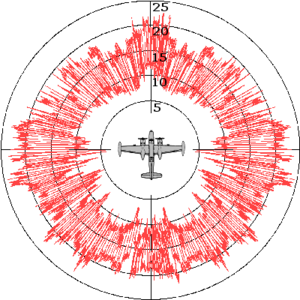This article includes a list of general references, but it lacks sufficient corresponding inline citations. (January 2014) |

Radar cross-section (RCS), denoted σ, also called radar signature, is a measure of how detectable an object is by radar. A larger RCS indicates that an object is more easily detected.[1]
An object reflects a limited amount of radar energy back to the source. The factors that influence this include:[1]
- the material with which the target is made;
- the size of the target relative to the wavelength of the illuminating radar signal;
- the absolute size of the target;
- the incident angle (angle at which the radar beam hits a particular portion of the target, which depends upon the shape of the target and its orientation to the radar source);
- the reflected angle (angle at which the reflected beam leaves the part of the target hit; it depends upon incident angle);
- the polarization of the radiation transmitted and received with respect to the orientation of the target.
While important in detecting targets, strength of emitter and distance are not factors that affect the calculation of an RCS because RCS is a property of the target's reflectivity.
Radar cross-section is used to detect airplanes in a wide variation of ranges. For example, a stealth aircraft (which is designed to have low detectability) will have design features that give it a low RCS (such as absorbent paint, flat surfaces, surfaces specifically angled to reflect the signal somewhere other than towards the source), as opposed to a passenger airliner that will have a high RCS (bare metal, rounded surfaces effectively guaranteed to reflect some signal back to the source, many protrusions like the engines, antennas, etc.). RCS is integral to the development of radar stealth technology, particularly in applications involving aircraft and ballistic missiles.[2] RCS data for current military aircraft is mostly highly classified.
In some cases, it is of interest to look at an area on the ground that includes many objects. In those situations, it is useful to use a related quantity called the normalized radar cross-section (NRCS), also known as differential scattering coefficient or radar backscatter coefficient, denoted σ0 or σ0 ("sigma nought"), which is the average radar cross-section of a set of objects per unit area:
where:
- σ is the radar cross-section of a particular object, and
- A is the area on the ground associated with that object.[3]
- ^ a b "Radar Cross Section, Optical Theorem, Physical Optics Approx, Radiation by Line Sources" on YouTube
- ^ Cite error: The named reference
:0was invoked but never defined (see the help page). - ^ Ulaby, Fawwaz (1986). Microwave Remote Sensing: Active and Passive, Volume 2. Artech House, Inc. p. 463. ISBN 978-0-89006-191-6.
